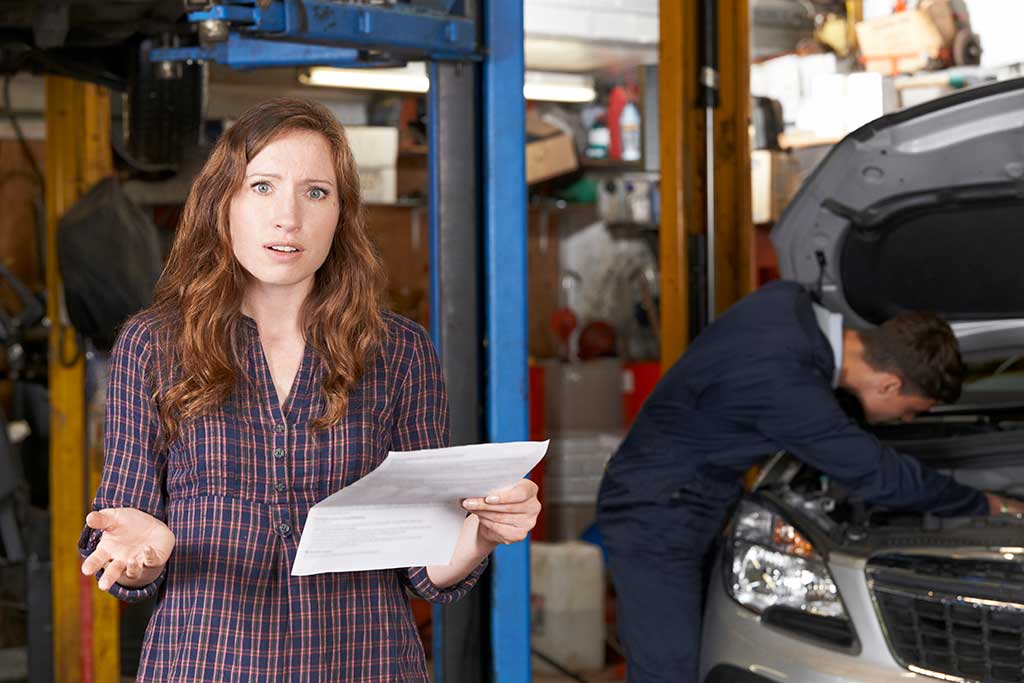How to Save Money on Car Repairs
Last updated May 2024

Because you often don’t know exactly what needs to be done until your car is at the shop, it’s difficult to determine whether the shop charges fair prices.
Checkbook’s Ratings for Price
To help you identify shops with low prices, our Ratings Tables report our price comparison score for each shop. To calculate these scores, our undercover shoppers called shops to get their prices for specific repairs (for example, replace the water pump for a 2016 Ford Focus SE using OEM parts). The scores show how each shop compared to the average price quoted for the same repairs. We set the average at $100. If two shops quoted on the same repairs, and one shop has a price comparison score of $120 while a second shop has a score of $100, it means the first shop’s quotes were 20 percent higher than the second shop’s.
The figure below illustrates the range of prices we found. For many of the repairs we checked, some shops charged twice as much as nearby competitors.
A striking observation about the data we collected: Choosing a low-priced shop doesn’t mean you’ll get lousy work. In fact, low-priced shops were more likely to receive high marks from their surveyed customers than high-priced shops. Shops with price comparison scores of less than $87 were rated “superior” for “doing work properly on the first try” by 87 percent of their surveyed customers, on average, while shops with price comparison scores above $113 received such favorable ratings from only 75 percent of their surveyed customers.
Independent Shops vs. Dealers
Our advice: If the work you need is not covered by a new-car warranty, use an independent shop. We consistently find that prices charged by dealers are significantly higher than those at independent shops, and that dealers don’t offer better quality service.
For Expensive Repairs, Get Several Estimates
If you know what repairs you need, compare prices by calling several shops for quotes: Our undercover shoppers find this surprisingly easy.
If you don’t know what’s wrong with your car, call one or more shops and describe the symptoms—staffers may be able to identify your problem and give you a price. If so, get quotes from several shops.
When shops can’t diagnose your car over the phone, take it in for an estimate. Then, with estimate in hand, check to see if the price is fair by comparing it with estimates from other shops or via RepairPal.com, which tracks car repair prices. Find a lower price elsewhere? You’ll have to pay the first shop for the diagnosis. Also, if your car isn’t drivable, you’ll have to pay to have it towed to a second shop (although AAA members can have their cars towed to a second shop for free to obtain a second opinion).
Check Labor Rates
Our Ratings Tables also report shops’ hourly labor rates. On average, the higher the labor rate the higher the repair price. But labor is just one element of what a shop charges, and some shops with high labor rates have low prices, and vice versa. If a shop calculates labor costs using a manual that allots generous amounts of time to each job, figures out labor costs according to “clock-time” but has slow mechanics, or adds a big markup to parts, it may have high prices even if its labor rate is low.
Check for Unreasonable Miscellaneous Charges
Before authorizing any work, find out what charges in addition to parts, labor, and tax will appear on your bill. Many shops add ambiguous “shop charges” (supposedly to cover things like grease, oil, rags, and hazardous waste removal) that can significantly increase the final bill. For example, when our shoppers obtained quotes for the replacement of a water pump, some shops included shop charges as high as $40.


